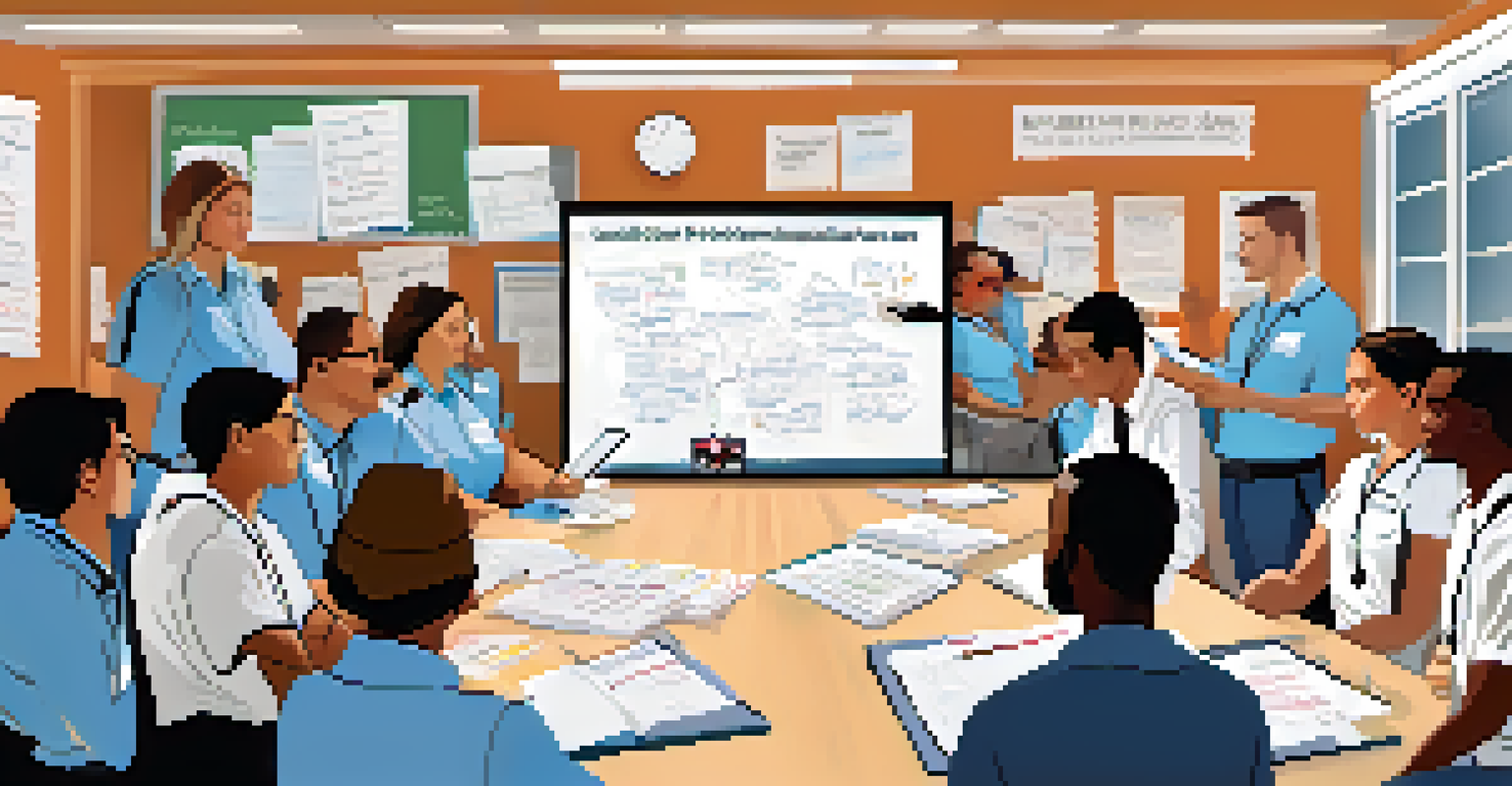The Role of Technology in Crisis Communication in Schools

Understanding Crisis Communication in Educational Settings
Crisis communication in schools refers to the strategies used to inform and guide students, staff, and parents during emergencies. This can range from natural disasters to security threats, where clear and timely information is crucial. The goal is to ensure safety while maintaining trust within the school community.
In times of crisis, communication is crucial to ensure safety and maintain trust within the community.
In recent years, the landscape of crisis communication has evolved significantly. Traditional methods like phone trees or printed notices are no longer sufficient in the digital age. Schools are now leveraging technology to disseminate information quickly and efficiently, adapting to the needs of a connected society.
By understanding the core principles of crisis communication, schools can better prepare for unexpected situations. This involves not only having a plan in place but also utilizing technology effectively to reach everyone involved. After all, in a crisis, every second counts.
The Power of Social Media in Crisis Situations
Social media platforms like Twitter and Facebook have become vital tools for schools during crises. They allow for real-time updates, enabling schools to communicate directly with students and parents. This immediacy can help dispel rumors and misinformation that often spread during emergencies.

For instance, during a weather-related emergency, a school can quickly post updates about closures or safety measures. This not only keeps everyone informed but also fosters a sense of community as parents and students engage in the conversation. Social media serves as a lifeline, connecting people when they need it most.
Crisis Communication Essentials
Effective crisis communication in schools relies on timely information sharing and the use of modern technology.
However, it's essential for schools to have a clear social media strategy in place. This includes designated personnel to handle communications and guidelines for what information to share. With the right approach, social media can be a powerful ally in crisis communication.
Utilizing Text Messaging for Immediate Alerts
Text messaging is one of the fastest ways to reach individuals during a crisis. Schools can implement systems that send out alerts directly to parents and students’ phones, ensuring critical information is received instantly. This method can be particularly effective, as most people carry their cell phones with them at all times.
The only way to deal with the future is to function efficiently in the now.
Many schools adopt mass notification systems that allow them to send out pre-programmed alerts for various situations, such as lockdowns or evacuations. These quick messages can save lives by instructing people on what actions to take. The simplicity and speed of text alerts can be invaluable in high-pressure situations.
Moreover, text messaging can be coupled with other technologies to enhance communication further. For example, a message can inform recipients to check social media or their emails for more detailed information, creating a layered approach to crisis communication. This ensures that everyone receives timely updates through their preferred channels.
Mobile Apps: A Centralized Communication Tool
Mobile apps designed specifically for school communication can streamline information sharing during crises. These apps can include features such as push notifications, emergency contacts, and access to important resources. This centralized approach ensures that all necessary information is readily available at users' fingertips.
For instance, a school might develop an app that allows parents to receive notifications about emergencies and access resources like counseling services or safety tips. This not only keeps the community informed but also provides additional support during trying times. The convenience of having everything in one place can enhance overall safety.
Leveraging Social Media
Social media serves as a vital tool for real-time updates, helping schools to connect with their communities during emergencies.
As schools continue to adopt these technologies, it's crucial to promote their use among parents and students. Training sessions or informational resources can help familiarize the community with the app, ensuring that everyone is equipped to respond effectively when a crisis arises.
The Role of Video Communication in Crisis Management
Video communication tools, such as Zoom or Google Meet, have gained popularity in crisis situations. Schools can use these platforms to conduct virtual meetings with staff, parents, and even emergency responders. This immediate face-to-face interaction can help clarify information and foster a sense of connection during stressful times.
For example, during a lockdown situation, a school administrator might hold a live video briefing to keep everyone updated on the situation. This approach not only provides real-time information but also allows for questions and answers, addressing concerns as they arise. Video communication can bridge the gap when in-person meetings aren't possible.
However, it's essential to ensure that all participants have access to the required technology and internet connectivity. Schools might consider providing resources or alternative solutions for those without reliable access. Ultimately, leveraging video communication can enhance transparency and trust within the school community during crises.
Training Staff for Effective Crisis Communication
Even with the best technology in place, the effectiveness of crisis communication relies heavily on staff training. Educators and administrators need to be familiar with the tools and strategies available to them. Regular training sessions can help ensure that everyone knows their role during a crisis and how to utilize technology effectively.
For instance, schools can conduct drills that simulate various crisis scenarios, allowing staff to practice using communication tools under pressure. These drills can reveal gaps in preparedness and provide opportunities to refine processes. Familiarity with technology can significantly enhance response times in real situations.
Training for Preparedness
Ongoing staff training and student involvement are crucial for ensuring effective crisis response and communication.
Additionally, involving students in training can create a culture of preparedness. By teaching students how to respond and communicate during a crisis, schools can empower them to take an active role. This collaborative approach can strengthen the overall safety and resilience of the school community.
Evaluating Communication Strategies After a Crisis
Once a crisis has passed, it's crucial for schools to evaluate their communication strategies. Analyzing what worked and what didn't can provide valuable insights for future preparedness. This reflection can highlight strengths to build upon and weaknesses to address, ensuring continuous improvement.
Feedback from staff, students, and parents can be instrumental in this evaluation process. Surveys or focus groups can gather perspectives on the effectiveness of communication during the crisis. This inclusive approach not only identifies areas for improvement but also fosters a sense of community and collaboration.

Ultimately, by continually assessing and refining communication strategies, schools can enhance their crisis response efforts. This commitment to improvement demonstrates a proactive approach to safety, reassuring the community that their well-being is a top priority.
The Future of Technology in School Crisis Communication
Looking ahead, technology will undoubtedly continue to play a crucial role in crisis communication within schools. As new tools and platforms emerge, schools will need to stay adaptable and open to change. Embracing innovative solutions can enhance communication efforts and overall safety.
For instance, advancements in artificial intelligence and machine learning could enable schools to analyze data and predict potential crises. This proactive approach could help schools prepare and communicate more effectively. The possibilities are exciting, and the future holds great promise for enhancing safety through technology.
However, it’s essential to balance technology with human connection. While tools can facilitate communication, the human element remains vital in crisis situations. Schools must prioritize building relationships and trust within their communities, ensuring that technology complements, rather than replaces, genuine interaction.